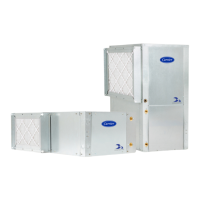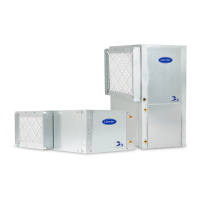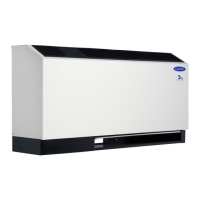31
SCROLL COMPRESSOR ROTATION
It is important to be certain compressor is rotating in the proper di-
rection. To determine whether or not compressor is rotating in the
proper direction:
1. Connect service gages to suction and discharge pressure fit-
tings.
2. Energize the compressor by using the thermostat or DDC
control to put the unit in cooling mode. 3. The suction pres-
sure should drop and the discharge pressure should rise, as is
normal on any start-up.
If the suction pressure does not drop and the discharge pressure
does not rise to normal levels:
1. Turn off power to the unit. Install disconnect tag.
2. Reverse any two of the unit power leads.
3. Reapply power to the unit and verify pressures are correct.
The suction and discharge pressure levels should now move
to their normal start-up levels.
When the compressor is rotating in the wrong direction, the unit
makes more noise and does not provide cooling.
After a few minutes of reverse operation, the scroll compressor in-
ternal overload protection will open, thus activating the unit lock-
out. This requires a manual reset. To reset the lockout, turn the
thermostat on and then off or power cycle the unit power feed.
NOTE: There is a 5-minute time delay before the compressor will
re-start.
COOLING MODE START-UP
1. Using the thermostat or DDC control, operate the unit in the
cooling cycle. Refer to Table 15 for operating limits. Allow
the unit to run for a minimum of five minutes and record the
operating data.
2. Check for water leaks and vibration
3. Check for cool air delivery at unit grille a few minutes after
the unit has begun to operate.
4. Verify that the compressor is on and that the water flow rate is
correct by measuring pressure drop through the heat
exchanger using P/T plugs. Check the elevation and cleanli-
ness of the condensate lines; any dripping could be a sign of a
blocked line. Be sure the condensate trap includes a water
seal.
5. Check the temperature of both supply and discharge water.
Compare to Tables 16-28. If temperature is within range, pro-
ceed. If temperature is outside the range, check the cooling
refrigerant pressures in Tables 16-28.
6. Check air temperature drop across the coil when compressor
is operating. Air temperature drop should be between 15°F
and 25°F.
7. Disable cooling mode and wait a period of 5 minutes to allow
system pressures to equalize.
HEATING MODE START-UP
1. After waiting for a period of 5 minutes after the cooling cycle,
use the thermostat or DDC control to operate the unit in the
heating cycle. Refer to Table 15 for operating limits. Allow
the unit to run for a minimum of five minutes and record the
operating data.
2. Check for water leaks and vibration.
3. Check for warm air delivery at unit grille a few minutes after
the unit has begun to operate.
4. Verify that the compressor is on and that the water flow rate is
correct by measuring pressure drop through the heat
exchanger using P/T plugs.
5. Check the temperature of both supply and discharge water.
Compare to Tables 16-28. If temperature is within range, pro-
ceed. If temperature is outside the range, check the cooling
refrigerant pressures in Tables 16-28.
6. Check air temperature rise across the coil when compressor is
operating. Air temperature rise should be between 20°F and
30°F.
7. Disable heating mode.

